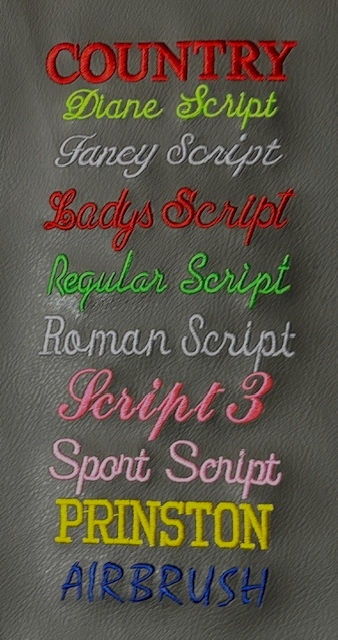The Art of Custom-made Embroidery: Opening the Keys to Creating Unique and Unforgettable Designs
Needlework, a craft steeped in practice and creativity, holds within its elaborate stitches the power to change material right into a canvas of special expression. The secrets to developing custom embroidery designs that mesmerize the eye and leave an enduring impact lie in a fragile balance of strategy, imagination, and attention to information. As we look into the world of personalized embroidery, we reveal the nuanced interplay between thread choice, stitch intricacy, and layout customization that elevates a simple garment to a masterpiece. Join us on a journey with the art of custom-made needlework as we unravel the mysteries behind crafting genuinely memorable and distinct creations.
Selecting the Right Embroidery Threads
When selecting needlework threads, what essential variables should you think about to ensure the ideal results for your custom layouts? The selection of embroidery string is crucial in establishing the final outcome of your stitched layout.
Moreover, the weight or density of the thread plays a substantial role in the appearance of the embroidery. Thicker strings can add dimension and appearance to your style, while finer threads are optimal for elaborate information and tiny text. In addition, thinking about the shade fastness and washability of the string is essential to make sure that your personalized designs keep their top quality and vibrancy gradually. By carefully evaluating these elements and picking premium strings that meet your details requirements, you can boost the visual charm and longevity of your stitched developments.
Exploring Different Stitch Methods
To look into the realm of 'Discovering Different Stitch Methods', one must comprehend the details and subtleties that each sewing approach brings to the art of embroidery. Various stitch methods not just add visual passion but likewise add to the general texture and measurement of the layout. One popular stitch strategy is the satin stitch, which entails carefully stuffed parallel stitches to develop a smooth and shiny surface area, ideal for loading in forms and creating bold lays out.
On the other hand, the backstitch is a flexible technique commonly made use of for outlining and adding great details. It involves sewing backwards to create a strong line of needlework. Additionally, the French knot stitch includes a tactile component to designs, excellent for producing distinctive accents like blossom facilities or attractive touches.
Exploring different stitch techniques allows embroiderers to have fun with light, shadow, and depth within their layouts, raising the aesthetic appeal and imaginative high quality of their embroidery tasks. By understanding numerous sewing methods, one can unlock unlimited opportunities for creating unique and unforgettable customized needlework pieces.
Incorporating Personalized Layout Aspects
Having explored the ins and outs of various stitch strategies such as the satin stitch, backstitch, and French knot, the emphasis currently shifts in the direction of integrating customized style components in customized needlework tasks. Customized layout components play a vital role in making embroidery projects really one-of-a-kind and memorable.
An additional means to incorporate individualized advice layout elements is by consisting of signs or motifs that hold unique significance to the recipient or mirror their rate of interests and character. Incorporating a favored blossom, animal, or hobby-related symbol can make the needlework design more purposeful and customized. Furthermore, choosing shades that reverberate with the recipient or align with the intended style can further improve the personalization of the embroidery task.
Mastering the Art of Shade Coordination

One key facet of shade sychronisation is understanding shade theory. This includes recognizing just how various colors communicate with each various other, the emotions they communicate, and exactly how they can be combined to produce aesthetically attractive designs. By applying shade concept principles, embroiderers can develop harmonious shade schemes that improve the total appearance of the style.
Additionally, focusing on contrast is critical in color sychronisation. Utilizing contrasting colors can assist particular components of the design pop, improve readability, and produce an aesthetically vibrant needlework item. By mastering the art of color coordination, embroiderers can raise their designs and develop memorable items that resonate with clients and customers alike.
Enhancing Structure With Advanced Needlework Stitches
French knots, for example, are excellent for including little, increased dots to your design, resembling the appearance of grains or developing a textured surface area. Bullion knots, on the other hand, can be made use of to develop twisted, ropelike components that include an extravagant feeling to the embroidery. Seed stitching entails small, scattered stitches that can fill out areas with a multicolor texture, while turkey work creates cosy, dimensional accents similar to animal hair or vegetation. Exploring with these innovative needlework stitches permits you to push the boundaries of traditional embroidery and produce absolutely distinct and visually enticing structures in your designs.
Final Thought
To conclude, the art of custom-made embroidery involves a mix of selecting the right threads, checking out various stitch strategies, incorporating customized style aspects, grasping shade coordination, and boosting texture with advanced stitches. By understanding and implementing these crucial elements, embroiderers can create one-of-a-kind and memorable layouts that showcase their imagination and ability. Embroidery fanatics can unlock the tricks to creating stunning and bespoke pieces that stand out and leave an enduring impression.